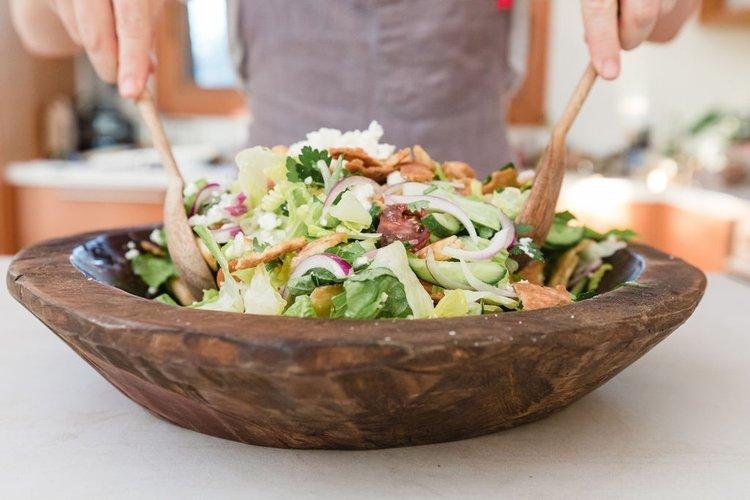They’re perfect produce packaging. It’s impossible to imagine one without the other. It’s also impossible to ignore the fun in fact-checking our favorite foods.
Let’s take a look at the differences between romaine hearts vs. heads.
Romaine Hearts or Heads: What Are the Differences?
Romaine hearts (left) and romaine heads (right)
When it comes down to romaine hearts vs. leaves, how do you choose sides?
We prefer to cheer on both because they combine to deliver the best of two lettuce types.
Romaine offers both the nutritional value of leafy lettuces and the juicy crispness of head lettuces.
As you consider tender romaine hearts and their flavorful outer leaves, these five food facts carry significant weight.
1. What are romaine heads and hearts?
Whole romaine lettuce boasts a proud heritage that dates back to the ancient Egyptians.
Their hieroglyphics from 4500 BC are graced with leafy vegetables that strongly resemble our modern romaine.
You can purchase a similar variety of Lactuca sativa today as whole heads, or you can buy the hearts already trimmed of their outer leaves.
The sturdy heads and crisp hearts offer a wide range of culinary possibilities that make this salad green tastefully unique.
2. How are romaine heads and hearts harvested?
Here at Hitchcock Farms, we grow and harvest premium romaine year-round. Our teams do the bulk of the work by hand.
Romaine heads are harvested by cutting each one at its root base. Individual hearts are prepped by trimming the whole head down to its crispy inner leaves.
After a good field rinse and close inspection, we transfer the romaine heads and hearts to cool storage.
From there, we pack and ship the harvest fresh from our fields to your table.
3. How are romaine hearts and heads different?
The obvious difference between hearts and heads comes clearly into view when you peel open a head of romaine.
The outer wrapping sports a rich, dark green color while the inner core reflects softer, paler shades.
This contrast may be the source of some nutritional confusion.
The color of romaine’s components doesn’t affect the levels of healthy goodness served up by either hearts or heads. It’s simply the result of California sunshine.
The outer leaves on whole heads enjoy more exposure, and that increases chlorophyll production while the hearts remain a pale shade of green.
4. How are romaine hearts and heads alike?
Romaine hearts and heads boast the same impressive nutritional profile.
The popular lettuce scores very high marks per 1-cup serving with 8 calories and a full gram of dietary fiber.
It’s an appetizing source of vitamins A, C and K as well as protein, iron and calcium.
If you’re designing a healthy diet around veggies that deliver plenty of natural goodness, romaine lettuce belongs at the top of your grocery list.
If you’re developing a restaurant menu that showcases guest-pleasing, veggie-centric choices, this premium produce serves up delicious versatility.
5. Caesars love hearts
Julia Child often shared a wonderful story about her first Caesar salad and how she enjoyed it with her family at a Tijuana restaurant.
Her brief and delightful memoir seems to confirm the origins of this classic dish that still centers around pale, slightly sweet hearts of romaine lettuce.
In the nearly 60 years since then, that simple salad has become world-famous and still wows admiring appetites at home dinners and restaurant tables.
The Caesar maintains its classic status by lending itself to irresistible versions of the original. That’s a quality we always admire in food stars.
6. Romaine heads serve with style
Crisp texture and a rich green color make romaine heads natural ingredients for all kinds of dishes.
Apply artful knife skills, and heads become a stylish addition to veggie sides or a garnish for sophisticated plates. Stack, roll and slice a romaine chiffonade to shower over your next entree salad.
Root to stem cooking also inspires home and professional chefs to incorporate nutritious romaine into different recipes.
This trend is finally becoming a menu regular embracing the entire head of lettuce, and that’s a culinary attitude we’re very happy to endorse.
7. They work together so well
Hearts will always be the center of Caesar salads. We appreciate the tasty touches romaine heads bring to a plate. Keep hearts and heads together, and this versatile vegetable bridges cultural and national borders.
There aren’t many other lettuces that boldly take the heat in a kitchen like a hearty head of romaine.
Rinsed, drained and chopped, heads and hearts can pan fry or slow roast. Slice a head in half, braise it with bacon and mustard, and celebrate how a whole head of lettuce can sometimes be greater than the sum of its parts.
Romaine Lettuce Recipes You’ll Love
Let's wrap up with a few more recipes for this almost inseparable pair.
Everyone relishes creative culinary options, so we offer these ideas for making the most of whole heads and romaine hearts.
Romaine and Apple Salad – Halved romaine heads serve as deliciously edible bowls for a salad of sliced apples topped with homemade blue cheese dressing.
Romaine Salade Nicoise – Give your next romaine salad an elegant French accent by chopping and tossing the head with fresh veggies and a lemon dressing.
Bacon and Chicken Ranch Wrap – Trim outer leaves from a head of romaine, and wrap them around an irresistible combo of sauteed chicken, chopped bacon and Roma tomatoes.
Grilled Romaine Hearts – Put grilled romaine hearts on your list of nutritious vegetables that make backyard cookouts extra tasty and healthy too.
Curry Chicken Salad and Romaine Hearts – Yes, chicken salad served on crisp hearts of fresh romaine can be an amazing finger food and the star of your next casual lunch get-together.
We Applaud Both
We hope you’ve enjoyed this light-hearted take on learning more about romaine lettuce. It’s our goal to inform and educate both food service professionals and consumers. It’s our hope that we can be a little entertaining too.
As a leader among California produce growers, we firmly support both romaine hearts and heads.
We applaud their place in our commercial walk-ins and home refrigerators. You can always trust us here at Hitchcock Farms to keep you supplied with a winning variety of vegetables straight from our fields to your tables.
FAQ
1. How many cups in a head of romaine?
Shredding or chopping an average head of romaine lettuce yields between 5 and 6 cups. The center heart typically yields 2 cups. Both weigh in at approximately 2.5 ounces per cup.
2. How many calories are in one head of romaine lettuce?
A head of romaine weighing 625 grams contains approximately 110 calories. That breaks down to an average 8 calories per cup of shredded romaine lettuce.
3. How long does romaine lettuce last in the refrigerator?
When stored properly, a whole head of fresh romaine lettuce can keep for as long as 20 days in the refrigerator. Romaine hearts should last from one week to 10 days.







